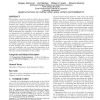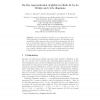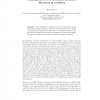466 search results - page 76 / 94 » How to study artificial creativity |
ATAL
2010
Springer
13 years 11 months ago
2010
Springer
We introduce a novel case study in which a group of miniaturized robots screen an environment for undesirable agents, and destroy them. Because miniaturized robots are usually end...
AI
2008
Springer
13 years 10 months ago
2008
Springer
This article is inspired by recent psychological studies confirming that a child is not born a blank slate but has important innate capabilities. An important part of the "le...
BMCBI
2011
13 years 4 months ago
2011
Background: Methods of determining whether or not any particular HIV-1 sequence stems - completely or in part - from some unknown HIV-1 subtype are important for the design of vac...
ACRI
2008
Springer
14 years 4 months ago
2008
Springer
Abstract. Rule 54, in Wolfram’s notation, is one of elementary yet complexly behaving one-dimensional cellular automata. The automaton supports gliders, glider guns and other non...
ECAL
2001
Springer
14 years 2 months ago
2001
Springer
Some benefits of a dialogue between evolutionary robotics and developmental ethology are presented with discussion of how developmental models might inform approaches to evolution...



